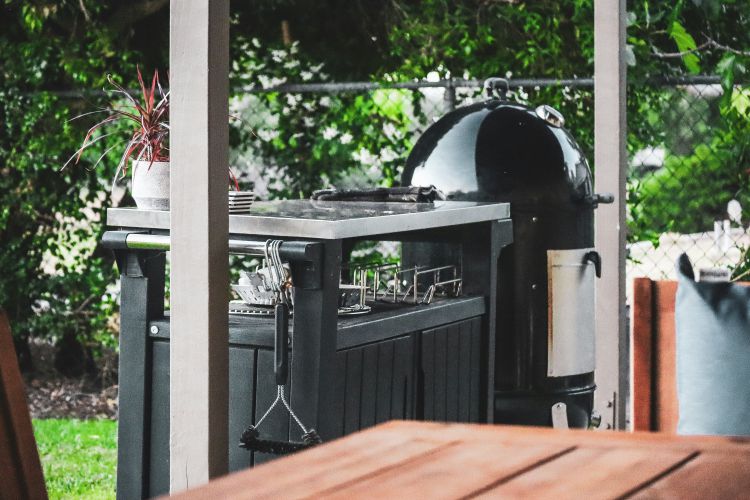Most homeowners say that having a great outdoor space is just as important as their indoor setup. But here’s the catch—many backyards sit unused for months once the weather shifts. That’s often because outdoor kitchens aren’t built for year-round use. Most are set up just for summer grilling or weekend cookouts.
Whether you live in a mild climate or get occasional weather swings, planning your space with comfort and function in mind makes a big difference. This guide shares clear, useful design ideas that help you create an outdoor kitchen that looks good, performs well, and stays practical—no matter the time of year.
1. Build a Covered Layout for All-Season Use
If you want to use your outdoor kitchen often, you’ll need a roof or some form of covering. A basic pergola, a solid pavilion, or even a retractable awning can do the job. These structures keep your appliances, food, and guests safe from sun and rain. Plus, they give you shade when temperatures rise and shelter when they drop.
A covered space also makes it easier to add things like lights, fans, and heaters later on. It adds structure to your outdoor layout and helps define the kitchen zone. If you’re updating an existing patio, think about adding a roof that ties into your current home design for a clean look.
2. Choose Materials That Can Handle the Weather
Not all materials do well outdoors. You need surfaces and finishes that won’t rust, fade, or crack as the seasons change. Stainless steel is a good pick for appliances since it holds up well in heat and rain. For counters and flooring, natural stone works best.
Lueders stone is a popular option because it’s strong, versatile, and holds up year-round. It comes in a range of colors like grey, brown, and caramel, which makes it easy to match with your home style. Whether you use it for countertops, cladding, or floors, it adds both function and beauty without much upkeep.
3. Add Heating Features for Colder Days
An outdoor kitchen doesn’t need to shut down when temperatures dip. You can stay warm with the right heating features. Wall-mounted infrared heaters, portable propane units, or even a small fire pit can make a big difference. These options create warmth without taking up much room.
If your space has a roof or pergola, it’s easier to install overhead heaters that keep the whole area warm. Just be sure to follow safety rules and keep them away from anything flammable. With good heating, you can keep using your outdoor kitchen into the fall and winter without feeling the chill.
4. Use Fans and Shade to Beat the Heat
In the warmer months, it’s just as important to keep things cool. Installing a ceiling fan under your kitchen cover can improve air flow and reduce humidity. Some people also add misting systems or place box fans near seating areas to push the air around.
If your cooking zone gets a lot of direct sunlight, consider installing a shade sail or adding curtains to block the sun during peak hours. These simple changes can make outdoor cooking a lot more comfortable and enjoyable, especially in areas with long, hot summers.
5. Pick Appliances That Match How You Cook
Choosing the right appliances can make or break your outdoor kitchen. Don’t buy everything at once or pick what looks trendy. Start by thinking about what you actually cook. If you grill often, a built-in gas or charcoal grill should be your main focus. If you enjoy baking or entertaining, a pizza oven or smoker may be worth adding.
Stick with fewer appliances that serve your habits. It’s better to invest in one high-quality grill than buy three cheaper ones you barely use. Make sure your setup includes enough space around each appliance for prep and cleanup. Also, leave room for any add-ons you might want later, like a side burner or small fridge.
6. Add Smart Storage to Keep Things Tidy
Storage often gets overlooked, but it matters more than you think. Without proper places to put tools, dishes, or supplies, your space will feel cluttered fast. Look for cabinets made from waterproof materials like stainless steel or sealed wood. These hold up better when exposed to moisture or heat.
Built-in storage works well under counters. Include drawers for cooking utensils, a pull-out trash bin, and shelves for dry goods or seasonings. Having everything within reach saves time and keeps you from running in and out of the house. Add locks if you’re storing anything valuable or heavy-duty.
7. Use the Right Lighting in the Right Spots
Lighting helps your outdoor kitchen work well after dark. You don’t need anything fancy, but you do need it placed right. Use task lighting over grills, counters, and sinks so you can see clearly while working. Wall-mounted or under-counter lights can also improve visibility without taking up space.
For dining or lounge areas, softer lights work best. String lights, LED strips, or solar lanterns can make the space feel cozy without blinding your guests. Choose energy-efficient options to keep power use low. If you already have a covered roof, wiring becomes easier, and you get more lighting options.
8. Set Up a Spot to Eat or Relax Nearby
Your outdoor kitchen works better when there’s a nearby space to sit and eat. A simple dining table with a few chairs can do the trick. If you want a more relaxed setup, consider lounge seating with weatherproof cushions. Just make sure the materials can handle both sun and rain.
Arrange the dining area at a safe distance from the cooking zone. You want people to enjoy the space without crowding the grill or standing too close to the heat. Cover the seating area if possible to protect it and make it usable all year. This also helps guests stay comfortable, even if the weather shifts during your meal.
Creating an outdoor kitchen that works year-round doesn’t mean spending a fortune. It means planning smart. Think about how you cook, how often you entertain, and what the weather is like where you live. Then choose features that help you enjoy the space no matter the season.
Covered roofs, reliable materials, proper storage, and thoughtful lighting all come together to create a space that’s easy to use and fun to share. With the right setup, your outdoor kitchen becomes more than a place to cook—it becomes a regular part of your home that adds value, comfort, and style every month of the year.

